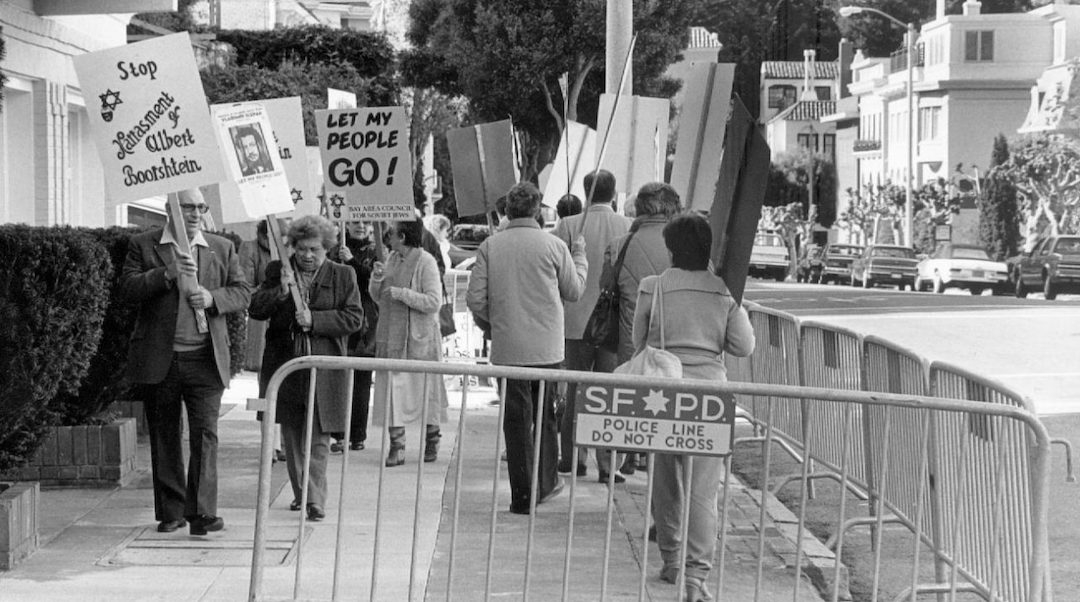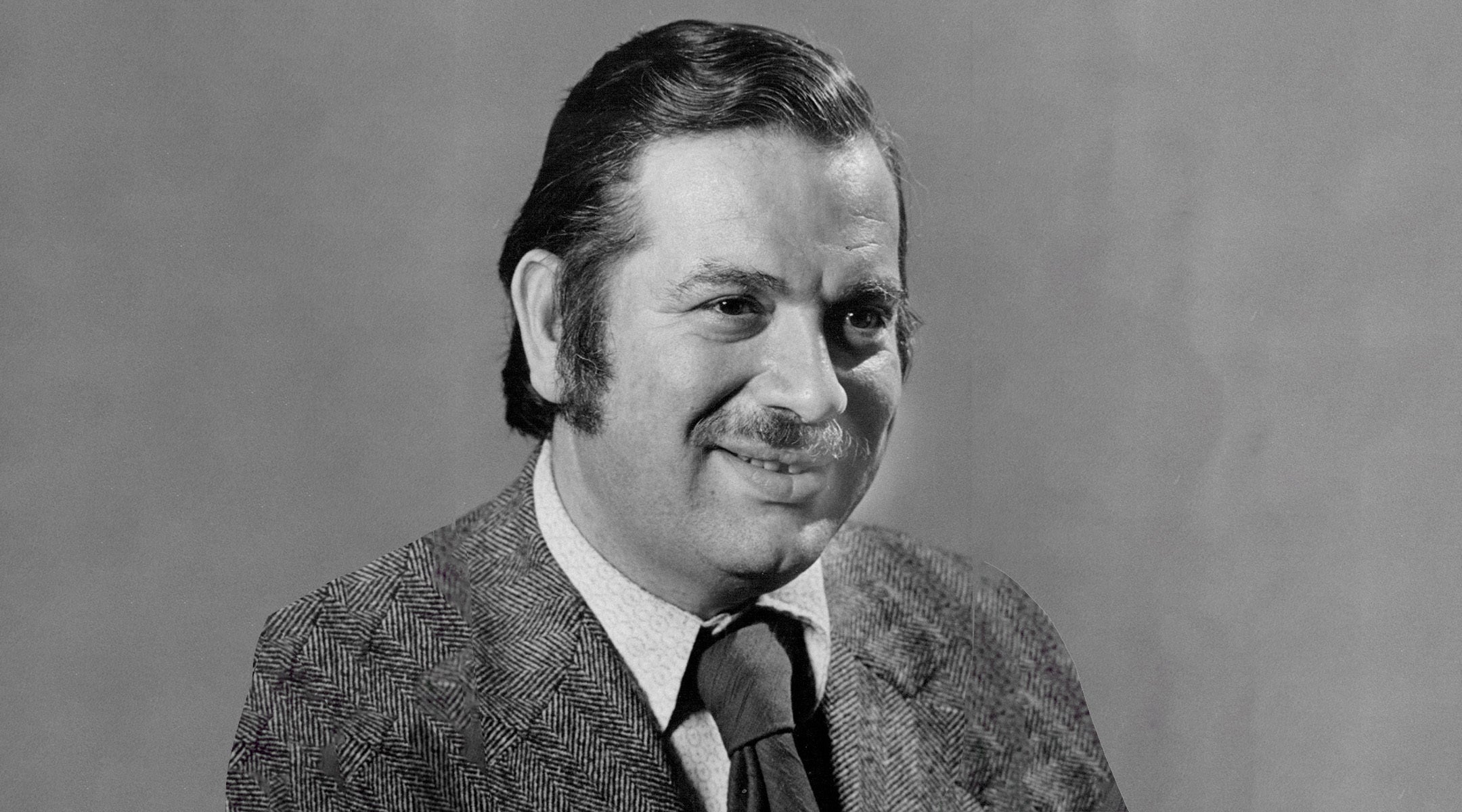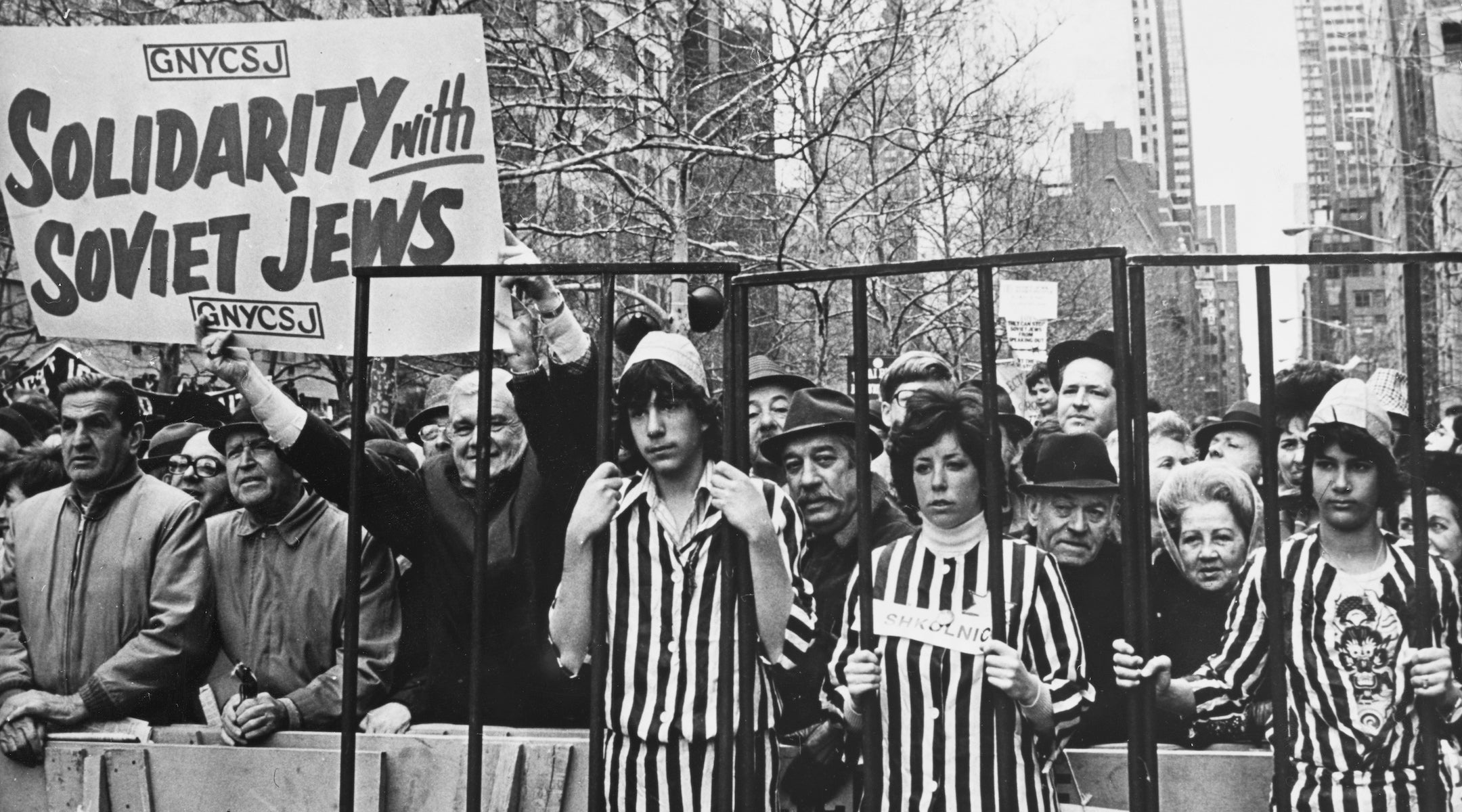Soviet Jewry protest leaders in San Francisco secretly recruited help from Jews for Jesus, FBI file says
If the FBI’s intelligence is accurate, a movement that unified much of the global Jewish community relied at least to some extent on the support of a reviled group whose mission is to proselytize to Jews

Bay Area Council for Soviet Jews’ daily vigil in front of the Soviet Consulate, Nov. 24, 1986. (Tom Wachs/J. The Jewish News of Northern California)
(JTA) – Organizers of protests on behalf of Soviet Jewry in San Francisco in the early 1970s might have bolstered crowds by secretly recruiting participants from Jews for Jesus.
The explosive revelation that Jewish leaders turned to a Christian missionary group for help appears in a 1973 FBI memo that the Jewish Telegraphic Agency recently obtained through a freedom of information request.
The FBI file details an apparent relationship between Martin Rosen, the founder of Jews for Jesus, and Joel Brooks and Harold Light, two prominent San Francisco Jewish leaders at the fore of local efforts in the movement to get Soviet authorities to end restrictions on the emigration of the country’s Jewish population. The relationship outlined in the declassified memo has not appeared in scholarship on the Soviet Jewry movement, nor is it known to activists of the movement who were interviewed by JTA. Light, Brooks and Rosen are deceased.
If the FBI’s intelligence is accurate, a successful and cherished social movement that unified much of the global Jewish community in common purpose for decades relied at least to some extent in San Francisco on the support of a group, rejected by nearly all of that community, whose mission is to proselytize to Jews.
“The first thing I thought of was, I’m reading something from ‘The Twilight Zone’ — in my many years in the Soviet Jewry movement, I don’t know if I’ve seen a document as strange as this,” said Morey Schapira, who served in leadership positions in the Student Struggle for Soviet Jewry, the Bay Area Council for Soviet Jews, and the Union of Councils for Soviet Jews. “The idea of working with a slimy group like Jews for Jesus, it’s beyond my comprehension.”
The public can request any FBI files that may exist pertaining to deceased individuals. An FBI memo relating Rosen arrived last November in response to one of about 50 freedom of information requests on prominent figures in recent Jewish history submitted by JTA almost two years ago. Most of JTA’s requests are still pending. TO DOWNLOAD THE FBI FILE, CLICK HERE.
Dated May 24, 1973, and written by an FBI informant whose name was redacted by staff at the U.S. National Archive, the memo focuses on Brooks, who was the Northern California director of the American Jewish Congress for about 30 years starting in 1967.
“[Brooks] has heavily utilized the services of the young Jews in the Jews for Jesus group,” the informant wrote. “[He] has used these services to turn out people in his Soviet Jewry demonstrations.”
The informant also cites Brooks as saying that Light, leader of the Bay Area Council for Soviet Jewry, used members of Jews for Jesus in a “hush-hush way” to distribute leaflets and participate in demonstrations.
The memo spells out why such an arrangement would be best kept out of the public eye.
“All of this, of course, is secret, because organized Jewish groups, and the various rabbinical councils have proclaimed that Jews for Jesus are no longer Jews but have become apostates, and should not be palled around with, nor buried in Jewish cemeteries,” the informant writes.

The upside for Rosen was obvious: His group would gain a foothold in a popular Jewish movement, offering a potential avenue toward legitimacy and a pool of possible recruits. In his 1974 memoir, titled “Jews for Jesus,” Rosen openly discussed being accepted into the movement by Jewish organizers, but he did so without naming Brooks, Light or any others.
He wrote that Jews for Jesus were invited because of their reputation as the “best qualified, best disciplined demonstrators in the San Francisco community. We’ve had more experience than other Jewish groups and are familiar with the applicable laws and regulations.”
Rosen’s group committed to not use the demonstrations as an opportunity to evangelize and didn’t bring any Christian literature or wear outfits that would identify them, according to the memoir.
“Many Jews for Jesus believe in the freedom of Soviet Jewry just as strongly as any other Jews, and we want to be as effective as possible when we demonstrate to support that cause,” Rosen wrote.
To Schapira, who led the Bay Area Council for Soviet Jews for years and knew both Brooks and Light, however, it’s unclear why the Soviet Jewry movement would have wanted or needed Jews for Jesus. Schapira didn’t recall it ever being especially difficult to turn out demonstrators organically. There didn’t seem to be a need to resort to secret deals.
“If you look at the picture of the rallies in those days, they even had people like [American folk music legend] Joan Baez,” Schapira said. “They developed a relationship with her and she would come to the rally and bring her guitar and sing songs for freedom.”
He added, “If we needed an instant rally, we were a grassroots organization and we could produce 10 or 12 people, which might be enough to send a message to the Russians and get some publicity in the local papers.”
At least a few people in the Bay Area’s Jewish community caught wind of the secret relationship between Brooks and Jews for Jesus at the time, according to the memo.
Stephanie Rodgers was a coordinator of the Jewish Defense League, an extremist right-wing Jewish group that was under heavy FBI surveillance. Founded by Rabbi Meir Kahane, the JDL applied its often violent tactics to resist Jews for Jesus’ public campaign to convert Jews. Rodgers visited Brooks’ office ahead of a planned demonstration in front of the Soviet consulate in San Francisco and asked about his connection to Rosen and Jews for Jesus, according to the memo.
After Brooks explained how they had been useful, Rodgers “smiled and was very pleasant on the surface,” the memo says. But at the demonstration, Rodgers and a group of other JDL activists showed up even though they said they would stay away, and they found Rosen in the crowd and proceeded to attack him and “kicked him in the groin.”
JDL regularly disrupted Jews for Jesus events; the organization would ultimately claim responsibility for firebombing a bus operated by Jews for Jesus in Brooklyn and abducting an adherent. In the Bay Area, where both groups were active, tensions were particularly high; the Jewish Defense League would sue the local Jews for Jesus chapter over what it charged was the group’s misuse of the JDL’s name and imagery.
Brooks, meanwhile, had more affable ties with Jews for Jesus. It’s unclear how or when Rosen and Brooks developed a relationship, but Brooks noted in a July 25, 1972, letter he wrote to the office of the American Jewish Congress in New York that their ties had started “some time ago.” The letter is found in the records of the Northern California branch of the American Jewish Congress, which are archived at the University of California Berkeley’s library.
A prominent advocacy group in its heyday, the American Jewish Congress — not to be confused with the American Jewish Committee — took a more liberal political stance than that of Jewish establishment groups on many issues.
Brooks had learned that his organization’s national headquarters wanted to undertake a study of Jews for Jesus and he wished to provide insight. He was under no illusion about the group’s objective: “The sole aim of these men is to enlist new converts to Christianity,” Brooks wrote in the letter.
“Through contact with Rosen I have developed a great deal of insight into how his organization operates, their source of funding, budget, etc. which I wish to share with you,” he added.
Then as now, members of Jews for Jesus and other Messianic groups felt unfairly rejected by the Jewish world, arguing that their Christian beliefs should have a place in the community.
In the early 1970s, when Jews for Jesus’ conversion drive was prominent and well funded, Brooks was perceived as more lenient, according to the foreword to the 2017 book “Converging Destinies: Jews, Christians, and the Mission of God.”
“Brooks tried to keep some of us connected to the Jewish community and Jewish life,” Calvin J. Smith wrote in the foreword. “I remember going with another Jew for Jesus to a Jewish consciousness raising session he held at a home in Marin County in the early 1970s.”
Glenn Richter was one of the founders of the Student Struggle for Soviet Jewry and operates as a walking encyclopedia of the movement.

He said the movement did collaborate with many Christians outside of Jews for Jesus. For example, he said there were Scandinavians, who, on weekend trips to Leningrad (today St. Petersburg), brought in Jewish material that was banned in the Soviet Union. Others set up safe houses in Finland in expectation of fleeing Soviet Jews. And the International Fellowship of Christians and Jews raised millions of dollars from evangelicals to help transport Soviet Jews to Israel.
“Of course, among these goodhearted souls are those who have conversion of Jews in mind, but I suspect most have wanted to fulfill their prophecy of ingathering Jews to Israel so that a Christian messiah could return,” Richter said.
In his eyes, Jews for Jesus represented a red line.
“Our Student Struggle for Soviet Jewry office on Manhattan’s West 72nd Street was down the block from a church with a Jewish Messianic constituency, and we would never, ever, try to work with them,” Richter said.
Andrew Esensten contributed research to this story.
This article originally appeared on JTA.org.















